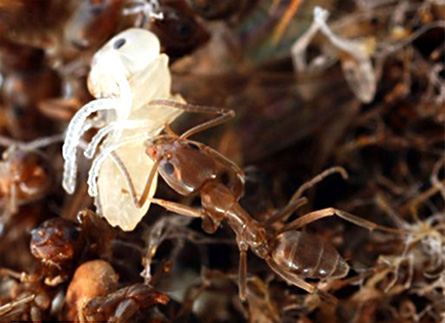Night of the living ants
Chemicals make the difference between life and death for these insects
 |
|
Ant nests have great undertaker capacity. Workers detect the dead and haul them outside to a pile of debris and corpses, often within an hour after death. Here a worker carries a young ant in the pupal stage to the refuse pile.
|
| Photo courtsey of the National Academy of Sciences and PNAS |
When an ant dies, other ants move the dead insect out of the nest. Sometimes, the dead ant gets moved away very soon — within an hour of dying. This behavior is interesting to scientists, who wonder how ants know for sure — and so soon — that another ant is dead.
One scientist recently came up with a way to explain this ant behavior. Dong-Hwan Choe is a biologist, a scientist who studies living things, at the University of California, Riverside. Choe found that Argentine ants have a chemical on the outside of their bodies that signals to other ants, “I’m dead — take me away.”
But there’s a twist to Choe’s discovery. These ants are a little bit like zombies. Choe says that the living ants — not just the dead ones — have this death chemical. In other words, while an ant crawls around, perhaps in a picnic or home, it’s telling other ants that it’s dead.
What keeps ants from hauling away the living dead? Choe has an answer for that question, too. He found that Argentine ants have two additional chemicals on their bodies, and these tell nearby ants something like, “Wait — I’m not dead yet.”
So Choe’s research turned up two sets of chemical signals in ants: one says, “I’m dead,” the other set says, “I’m not dead yet.”
Other scientists have tried to figure out how ants know when another ant is dead. If an ant is knocked unconscious, for example, other ants leave it alone until it wakes up. That means ants know that unmoving ants can still be alive. Many scientists, like Choe, think there must be a chemical on a dead ant’s body.
Choe suspects that when an Argentine ant dies, the chemical that says “Wait — I’m not dead yet” quickly goes away. Once that chemical is gone, only the one that says “I’m dead” is left. When other ants detect the “dead” chemical without the “not dead yet” chemical, they haul away the body. This idea — that some chemicals fade away — was Choe’s hypothesis, or idea to test, for his experiment.
To test his hypothesis, Choe and his team put different chemicals on Argentine ant pupae. A pupa is the stage of an ant’s life just before it becomes an adult. When the scientists used the “I’m dead” chemical, other ants quickly hauled the treated pupae away. When the scientists used the “Wait — I’m not dead yet” chemicals, other ants left the treated pupae alone. Choe believes this behavior shows that the “not dead yet” chemicals override the “dead” chemical when picked up by adult ants. And that when an ant dies, the “not dead yet” chemicals fade away. Other nearby ants then detect the remaining “dead” chemical and remove the body from the nest.
Understanding this behavior may help scientists figure out how to stop Argentine ants from invading new places and causing problems. Choe would like to find a way to use the newly discovered chemicals to spread ant killer to Argentine ant nests.
The ants’ removal behavior is important to the overall health of the nest. Their behavior is not so different from ours: When a human dies, the body is usually buried or cremated within a few days.
“Being able to quickly remove dead individuals and other possible sources of [disease] … is extremely important for all animals living in societies, including us,” says Patrizia d’Ettorre of the University of Copenhagen. “Think about all the effort and money that we invest daily in waste management.”
Power words: (from Yahoo! Kids Dictionary)
Hypothesis: A tentative explanation for an observation, phenomenon or scientific problem that can be tested by further investigation.
Chemical: A substance with a distinct molecular composition that is produced by or used in a chemical process.
Going Deeper:







